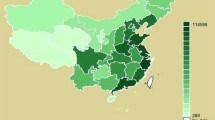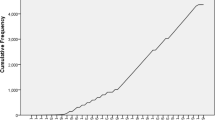Abstract
Facing bottlenecks of economic growth, two important policy concerns of the Chinese government are the regional fragmentation and ownership distortion. This paper extends the method of measuring structural efficiency of a group of firms to the existence of subgroups of firms to evaluate such issue. Without knowing the “true” prices, we argue that there is an output-oriented solution to the economy. We then apply this new method to the Chinese industrial sector from 2005 to 2014 as a case study. We found that resources were allocated efficiently among different regions but not within regions. In contrast, resources were allocated efficiently within different ownerships but not among ownerships. Specifically, by eliminating inefficient resource allocation among different ownerships, outputs of the whole industrial sector could be increased by 21% of the observed levels. These two findings cannot be derived directly from other existing methods. Our results advocate different directions to conduct further regional and ownership reforms in China.
Similar content being viewed by others
Notes
IMF World Economic Outlook Databases.
China is classified as an upper-middle-income country by the World Bank. https://datahelpdesk.worldbank.org/knowledgebase/articles/906519-world-bank-country-and-lending-groups
6 provinces (Gansu, Guizhou, Qinghai, Shaanxi, Sichuan, and Yunnan), 5 autonomous regions (Guangxi, Inner Mongolia, Ningxia, Tibet, and Xinjiang), and 1 municipality (Chongqing).
If this group includes all firms in an industry, one can call it “industry”.
Lozano and Villa (2004) called this centralized decision maker.
Nesterenko and Zelenyuk (2007) called this term “group potential revenue efficiency”.
Since the technically efficiency output vectors \({\boldsymbol{q}}_k^{te}\) can be derived from (A0, B0) for all k, the production pattern under technical efficiency Bte is not included as an argument of ATE. The same reason applies to (5) and (6). For further explanatiions of these aggregate measures, please see Li and Ng (1995).
Note that Φg depends on the aggregate inputs, aggregate outputs and output prices only whereas RAEg, AAEg and ATEg are all affected by the allocation of inputs and outputs.
Nesterenko and Zelenyuk (2007) introduced another decomposition of the revenue structural efficiency in which a component may contain both actions within individual firms without input reallocation and actions with input allocation.
There are different ways to solve the problem of unknown \({\boldsymbol{p}}^g\). If part of the price information is known, one may use, for example, Kuosmanen and Post (2001)’s method to derive the upper and lower bounds of efficiency measures based on the incomplete price information.
Data for 2012 were not available.
Note that for 1 output case: (i) all efficiency measures are price independent, and (ii) \(AAE = 1\) and it is not shown.
Probably it is related to the global financial crisis in 2008, but this is not our main focus here.
References
Färe R, Karagiannis C (2014) A postscript on aggregate Farrell efficiencies. Eur J Oper Res 233:784–786
Färe R, Zelenyuk V (2003) On aggregate Farrell efficiencies. Eur J Oper Res 146:615–620
Førsund FR, Hjalmarsson L (1979) Generalised Farrell measures of efficiency: an application to milk processing in Swedish dairy plants. Econ J 89:294–315
Grewal BS, Ahmed AD (2011) Is China’s western region development strategy on track? An assessment. J Contemp China 20(69):161–181
Hassard J, Morris J, Sheehan J, Yuxin X (2010) China’s state-owned enterprises: economic reform and organizational restructuring. J Organ Change Manag 23(5):500–516
Huang Y (2016) Can China escape the middle-income trap? China Econ J 9(1):17–33
Kuosmanen T, Post T (2001) Measuring economic efficiency with incomplete price information: with an application to European commercial banks. Eur J Oper Res 134:43–58
Li SK, Cheng YS (2007) Solving the puzzles of structural efficiency. Eur J Oper Res 180(2):713–722
Li SK, Ng YC (1995) Measuring the productive efficiency of a group of firms. Int Adv Econ Res 1(4):377–390
Lin JY, Zhang F (2015) Sustaining growth of the People’s Republic of China. Asian Dev Rev 1(32):31–48
Lozano S, Villa G (2004) Centralized resource allocation using data envelopment analysis. J Product Anal 22(1–2):143–161.
Lu Z, Deng X (2013) Regional policy and regional development: a case study of China’s western development strategy. Annales Universitatis Apulensis 15(1):250–264
Megginson W, Nash R, Randenborgh M (1994) The financial and operating performance of newly privatized firms: an international empirical analysis. J Finance 49:403–452
Nesterenko V, Zelenyuk V (2007) Measuring potential gains from reallocation of resources. J Product Anal 28(1–2):107–116.
Peyrache A (2013) Industry structural inefficiency and potential gains from mergers and break-ups: a comprehensive approach. Eur J Oper Res 230(2):422–430
Pritchett L, Summers LH (2014) Asiaphoria meets regression to the mean. NBER Working Paper 20573. National Bureau of Economic Research, Cambridge, MA
Song Z, Storesletten K, Zilibotti F (2011) Growing like China. Am Econ Rev 101:196–233
Wei Z (2004) Can the strategy of western development narrow down China’s regional disparity? Asian Econ Papers 3(3):1–23
Woo WT (2012) China meets the middle-income trap: the large potholes in the road to catching-up. J Chin Econ Bus Stud 10(4):313–336
Zheng J, Bigsten A, Hu A (2009) Can China’s growth be sustained? A productivity perspective. World Dev 37(4):874–888
Ylvinger S (2000) Industry performance and structural efficiency measures: solutions to problems in firm models. Eur J Oper Res 121:164–174
Author information
Authors and Affiliations
Corresponding author
Ethics declarations
Conflict of interest
The authors declare that they have no conflicts of interest.
Additional information
Publisher’s note Springer Nature remains neutral with regard to jurisdictional claims in published maps and institutional affiliations.
Appendix
Appendix
Rights and permissions
About this article
Cite this article
Tsang, Ck., Li, Sk. Allocation of resources within subgroups of an industry: a case study in the Chinese industrial sector. J Prod Anal 53, 125–139 (2020). https://doi.org/10.1007/s11123-019-00563-8
Published:
Issue Date:
DOI: https://doi.org/10.1007/s11123-019-00563-8
Keywords
- Chinese industrial sector
- Revenue structural efficiency
- Output-oriented structural efficiency
- Western development strategy
- Ownership reform




